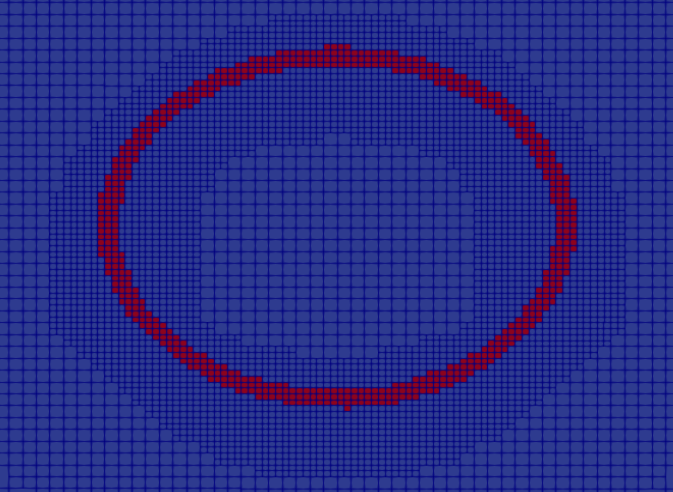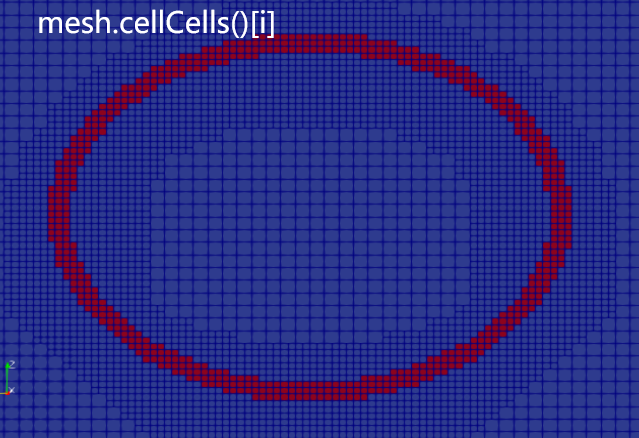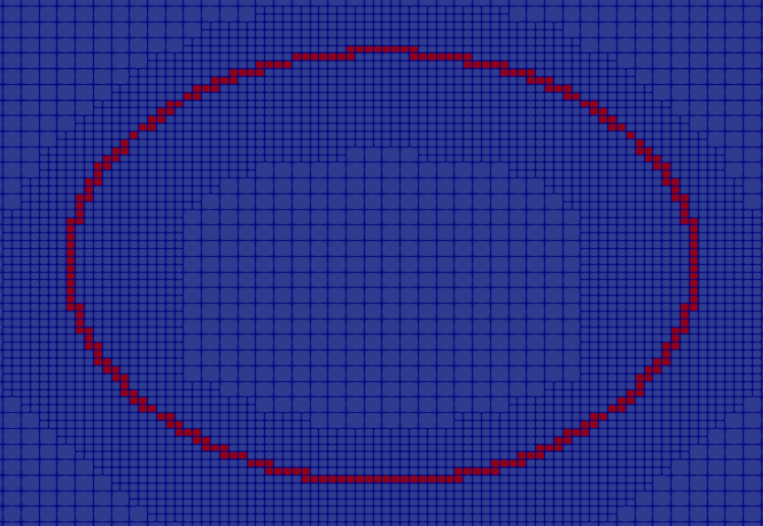标记气液界面附近一定距离的网格用于自适应网格加密
-
@李东岳
李老师好!
对于我的问题,我有两个思路,但限于水平太菜,两个思路都弄不出来:1.标记气液界面附近的一定层数的网格,也就是前面说的“内部5层外部5层的网格”。我找到的比较相关的代码位于AMR源文件的dynamicRefineFvMesh.C里:
// Extend with a buffer layer to prevent neighbouring points // being unrefined. for (label i = 0; i < nBufferLayers; ++i) { extendMarkedCells(refineCell); }这里的nBufferLayers是执行AMR时在dynamicMeshDict里填写的数字,可以通过这段代码控制缓冲层的层数。我想的是将气液界面标记成一个标量场(存在气液界面的网格赋值为1,其他网格赋值为0),并借鉴这段代码将标记区向内和向外“延拓”几个网格。但水平太菜,尝试了多次未能成功。
2.标记气液界面附近的的一定距离的网格。我想的是定义一个标量场,标量场的初始值都为0,然后对网格做遍历,只要网格到气液界面(0.001<α<0.999)的距离小于一定距离则该网格标量赋值为1。但是这种遍历很复杂我不知道该怎么写。
我的水平很菜,如果理解有偏差,表述有不清楚的地方望李老师指出
 谢谢李老师。
谢谢李老师。 -
@bestucan 多谢大佬费心,我昨天也看到了这个帖子,昨天我参照这个帖子做出了一个初级版本,能够实现对气液界面附近三层网格的标记。

我采用的代码是这样的:const labelList& neighbour = mesh.cellCells()[i]; scalar sum(0); forAll(neighbour, cellI) { sum += alpha1[neighbour[cellI]]; } sum /= neighbour.size(); if (sum>0.0001&&sum<0.9999) regionforinterface.field()[i]=1; else regionforinterface.field()[i]=0;后来,我想给它添加一个嵌套进去,那样就可以加密气液界面附近五层网格了,采用如下代码:
const labelList& neighbour = mesh.cellCells()[i]; for(int j=0; j<neighbour.size(); j++) { const labelList& neighbour2= mesh.cellCells()[neighbour[j]]; } scalar sum(0); forAll(neighbour2, cellI) { sum += alpha1[neighbour2[cellI]]; } sum /= neighbour2.size(); if (sum>0.0001&&sum<0.9999) regionforinterface.field()[i]=1; else regionforinterface.field()[i]=0;但是编译的时候提示neighbour2未申明:
error: ‘neighbour2’ was not declared in this scope forAll(neighbour2, cellI)

bestucan大佬,能麻烦您帮我看下第二段代码吗,我不知道该怎么改

另外,bestucan大佬,我的第一段代码是参照东岳老师之前的一个帖子改的,是通过对目标网格所有相邻网格的alpha场做平均,如果平均值位于标记范围内则该目标网格标记为1。
我想,能否改一下代码,使得只要目标网格的任意一个相邻网格alpha位于标记范围内则该目标网格标记为1。感觉应该用if判断语句,但这里的判断对象又是多个网格中的alpha值,我不知道该怎么写这段代码,麻烦大佬指点一下迷津。
bestucan大佬费心了,谢谢大佬
-
@ir77 因为你的
const labelList& neighbour2声明在 for 循环里,所以出了 for 循环无法使用挪外面,和 neighbour 放一起声明,然后在 for 里赋值
const labelList & neighbour = mesh.cellCells()[i]; const labelList & neighbour2; for (int j = 0; j < neighbour.size(); j++) { neighbour2 = mesh.cellCells()[neighbour[j]]; }得两步:
第一步,找出目标网格。
第二部,去判断目标网格并赋值找出目标网格这一步,新建一个数组,这个数组里放目标网格的网格ID,然后在第二步循环这个数组。
-
@bestucan bestucan 大佬您好,我提到的
只要目标网格的任意一个相邻网格alpha位于标记范围内则该目标网格标记为1
我通过下面这段代码解决了
const labelList& neighbour = mesh.cellCells()[i]; scalar sumforinterface(0); forAll(neighbour, cellI) { if (alpha1[neighbour[cellI]]>0.0001&&alpha1[neighbour[cellI]]<0.9999) sumforinterface += 1; else sumforinterface += 0; } if (sumforinterface>0) regionforinterface.field()[i]=1; else regionforinterface.field()[i]=0;然后我按照您建议的
因为你的 const labelList& neighbour2声明在 for 循环里,所以出了 for 循环无法使用
挪外面,和 neighbour 放一起声明,然后在 for 里赋值将const labelList & neighbour2;放到了外边,但是报错error: ‘neighbour2’ declared as reference but not initialized
好像是说需要初始化,我不知道该怎么弄
后来我在cfdonline上找到了一条和我问题类似的帖子。参照18楼的代码完成了代码修改,实现了对气液界面附近的更多网格的标记。

代码放在下面,供大家参考,我是初学者,代码写的不规范,大家见谅
const labelList& neighbour = mesh.cellCells()[i]; labelHashSet setNBCells(1); for(int j=0; j<neighbour.size(); j++) { const labelList & neighbour2= mesh.cellCells()[neighbour[j]]; setNBCells.insert(neighbour2); } labelList neighbour2=setNBCells.toc(); scalar sumforinterface(0); forAll(neighbour2, cellI) { if (alpha1[neighbour2[cellI]]>0.0001&&alpha1[neighbour2[cellI]]<0.9999) sumforinterface += 1; else sumforinterface += 0; } if (sumforinterface>0) regionforinterface.field()[i]=1; else regionforinterface.field()[i]=0; -
@bestucan 对了大佬,我还碰到了一个小小的问题:
@ir77 在 标记气液界面附近一定距离的网格用于自适应网格加密 中说:
const labelList& neighbour = mesh.cellCells()[i];
scalar sumforinterface(0);
forAll(neighbour, cellI)
{
if (alpha1[neighbour[cellI]]>0.0001&&alpha1[neighbour[cellI]]<0.9999)
sumforinterface += 1;
else
sumforinterface += 0;
}
if (sumforinterface>0)
regionforinterface.field()[i]=1;
else
regionforinterface.field()[i]=0;我把这段代码第一句中的mesh.cellCells()[i]分别改成了mesh.pointCells()[i]和mesh.edgeCells()[i],运行结果却非常糟糕(如下图),似乎只有mesh.cellCells()[i]才可以正常使用。
大佬您能从经验上帮我判断一下可能是哪里出错了吗

![b8691bcd-39b0-46d7-8a88-46a41411da64-}93K@JY~XZT%[R0_]{$5V%6.png](/assets/uploads/files/1650803378336-b8691bcd-39b0-46d7-8a88-46a41411da64-93k-jy-xzt-r0_-5v-6.png)
![bac9c337-2063-4585-8d8d-fface8c9a54b-C%6S~[G}}R]Z274E7Y0K0`D.png](/assets/uploads/files/1650803395252-bac9c337-2063-4585-8d8d-fface8c9a54b-c-6s-g-r-z274e7y0k0-96-d.png)
-
可能你想要用的是 mesh.cellPoints() 和 mesh.cellEdges()?
用一圈网格得到点,再用点得到相邻网格?
用一圈网格得到边,再用边得到相邻网格?参考:https://jibranhaider.com/blog/mesh-information-in-openfoam/
如果要从代码里看::
cellCells这个函数在这里:
[1] https://cpp.openfoam.org/v9/primitiveMeshCellCells_8C_source.html
第100行,它返回的指针 ccptr 是经过 calCellCells() 新建的。calCellCells()这个函数就在 [1] 的31行。73行新建,78行到95行寻找、赋值。edgeCells()这个函数在这里:
[2] https://cpp.openfoam.org/v9/primitiveMeshEdgeCells_8C_source.html
第32行,它返回的指针 ecptr 是经过 invertManyToMany() 更新的。而 invertManyToMany() 这个函数在
[3] https://cpp.openfoam.org/v9/ListOpsTemplates_8C_source.html
第 433 行。invertManyToMany() 中有两个 forAll 函数,函数中的 pointEdges 是函数的传入参数,也就是 [2] 中50行调用该函数时的第二个参数 cellEdges()。这个 cellEdges() 在
[4] https://cpp.openfoam.org/v9/primitiveMeshCellEdges_8C_source.html
中第118行。118行调用的函数 calcCellEdges() 就在 [4] 中32行。calcCellEdges() 中对 cellEdges() 返回指针 ceptr 的操作在104 和105行(104行用63行新建的ce初始化ceptr,105行用别名 cellEdgeAddr 对 ceptr 操作)。这个操作过程和[1]中73,74行类似。对比[4]中67,68和[1]中63,64。都有 own 和nei。不同的是[4]中对 own 和 nei 的两个循环,把结果都添加到 curCellEdges 了(83和99行),而 curCellEdges 是 ce 的引用,ce又在104行用于初始化ceptr。但是,它储存的方式和 [1] 中不一样。
有点晕了
 大概就是这么看。
大概就是这么看。用网页右上方搜索框搜函数,用 ctrl + F 网页高亮变量名,看出现和变动的位置。
-
大家好,我来更新这个问题的相关进展。最近两天我查了些资料,基本上解决了这个问题,感谢大家的帮助,尤其是bestucan大佬。
参考帖子关于相邻cell我写了个遍历进行暴力求解。
(1)代码思路:对所有网格做遍历,找到气液界面网格,针对每一个气液界面网格都对所有网格再做一次遍历,计算两网格之间的距离,对满足距离要求的网格在markRegionNearInterface这个场上+1。最后,可以利用markRegionNearInterface>=1来筛选出所有满足条件的网格。
(2)这段代码计算起来实在是费时间,因为我的需求(见贴名)不需要每一个时间步都运行这段代码,所以我在代码最外层套了一个时间步判断,可以实现多个时间步运行一次该代码。
(3)我从其他地方抄了点代码写了两个接口,分别从transportProperties读取 加密时间步间隔 和 加密范围,其中加密范围是依据气泡半径写的无量纲范围,所以需要配合前面代码(未在本段代码中给出)求出的气泡半径radius.value()定义标记区域。代码如下
//read timestep interval required for the following code, as the following code is very time consuming so I needn't it run for every timestep. const label calculateTimestepInterval = transportProperties.get<label>("calculateTimestepInterval"); //read information from transportProperties so that we can modify the size of marked region easily. scalar markRegionNearInterfaceSize = transportProperties.get<scalar>("markRegionNearInterfaceSize"); if (mesh.time().timeIndex() % calculateTimestepInterval == 0)//judge whether the timestep satisfy the timestep interval criterion. { markRegionNearInterface.field()=0;//reset the field to be zero first. Of course such field is claimed in createFields.H first. forAll(mesh.C(), i)//Cycle all meshes { if (alpha1[i]>0.0001&&alpha1[i]<0.9999)//judge whether the cell contains gas-liquid interface { vector centerOfSurfacePoint = mesh.C()[i];//store center information of such a interface cell forAll(mesh.C(), cellI)//Cycle all meshes again { scalar offset = mag(centerOfSurfacePoint - mesh.C()[cellI]);//distance between any cells and the interface cell if (offset <= markRegionNearInterfaceSize*radius.value())//judge the criterion, note the radius is calculated before with code which is not shown here { markRegionNearInterface.field()[cellI] += 1;//any cells which meet the criterion will be marked with value>0 } } } } }运行结果如下

BTW
(1) 因为我是个beginner,代码是东抄抄西抄抄弄出来的,上述代码可能有些冗余,如果大佬们有时间,想麻烦大佬们帮我看看我这些代码能从哪些角度优化优化。代码中的变量类型scalar vector label之类都是我一次次试错试出来的,也不知道这些变量类型用的合理不合理。
(2)我在代码中写了两个链接到transportProperties的接口读取 加密时间步间隔 和 加密范围,测试中发现程序只会在刚开始运行时读取这些常量。请问各位大佬,有没有什么办法能否让程序运行中也能读取这些常量呢?因为假设运行过程中我想改动这两个常量,目前只能把计算停下来改了后重新继续算,不能边算边改。




